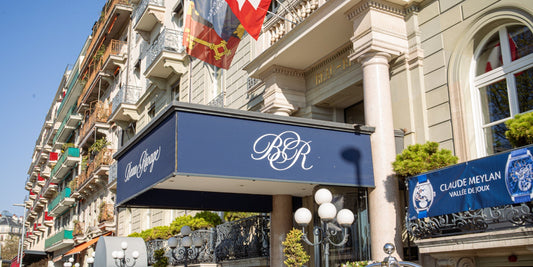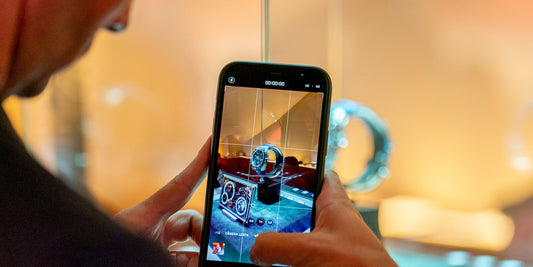In 2020, the brand Favre-Leuba can already look back to a history spanning 283 years. A history characterized by bold, pioneering thinking; numerous innovations and technological excellence. and consistently seizing new market opportunities.
What started with Abraham Favre’s small workshop in the Swiss municipality of Le Locle in 1737 developed rapidly into a manufacture whose watches were known worldwide for their high functionality, precision, and reliability under every climatic condition, and had very early on expanded into distant markets such as Brazil, Chile, India, and the USA.

Favre-Leuba Medals - Favre-Leuba archive [product ids="6381,6383,6532"]
Thanks to the integrated altimeter and barometer, their wristwatches reliably show them not only the height, but also the impending change in the weather. Based on this vital information, the two man roped party pitches a protective camp and thereby avoids a severe blizzard. Two days later - still in adverse conditions - exhausted but otherwise safe and sound, they reach the 4, 7 84 meter-high summit.

1963 Favre-Leuba Bivouac - Image Favre-Leuba archive
The two daredevils: Genevan mountain guide Michel Vaucher and Italian alpinist Walter Bonatti. Their watch: The Bivouac by Favre-Leuba.
The beginning: A tradition to innovate
After its launch in 1962, the Bivouac ranked among the indispensable companion of those who conquered frontiers in the high altitudes. As the world's first mechanical wristwatch with an aneroid barometer for altimetry and air pressure measurement, this tlmekeeper was an obvious and an ideal instrument for all pioneers. A sensation on the watch market - but only one of the many achievements of a brand whose founders had, more than two centuries prior, set their sights on defying the norms and developing ingenious watches that would function flawlessly and reliably under any climatic condition and in every conceivable situation.
Favre-Leuba is a brand whose history started on March 18th, 1737, when the watchmaking workshop of Abraham Favre was first mentioned in an official document in Le Locle - the birthplace of Swiss watchmaking in the present day canton of Neuchatel. The 35-year-old who came from a long-established, respected family, began his watchmaker apprenticeship in 1718 and was appointed ‘Maitre horloger du Locle’ (master watchmaker of Locle) around 1749. With his own workshop, he laid the foundation for a company that was soon renowned worldwide and, far into the 20th century, was to be headed by eight generations of the Favre family.
The passion for his craft, the constant pursuit of technical and aesthetic improvements, and the will to seize new market opportunities to grow the family business was passed on by the dedicated patron, who died at the age of 88 in 1790, to his son, also named as Abraham. On October 13th, 1792, the younger torchbearer, together with his sons Frederic and Henry-Louis, founded the company ‘A. Favre & Fils'. Henry-Auguste, Frédéric Favre’s son and thereby the fourth generation of the watchmaker family, joined forces in 1815 with the watch business of Auguste Leuba from Buttes in Val-de-Travers and traveled around the world - from Germany to Russia, through Cuba to New York, from Brazil to Chile - to establish their own workshop’s finely-made pocket watches in distant markets.
Fritz Favre, who married Adele-Fanny Leuba in 1855 and subsequently used the double surname Favre-Leuba, proved himself a worthy successor to his father Henry-Auguste and successfully pursued his expansion strategy in Europe, America, and Asia. In 1865 and 1867, he travelled to India and launched his brand as the first Swiss watch manufacturer in the subcontinent, which was to quickly develop into an important market for Favre-Leuba. Furthermore, the brand participated under his direction in national and international exhibitions and received numerous awards for its pioneering watches.
His children , particularly Henri Favre-Leuba, who assumed leadership of the family business in 1908 and remained president of the board of directors until his death in 1961 - relocated the company headquarters to Geneva and continued to steadily grow the brand.

Inside Favre-Leuba's Geneva factory in 1964 - Image Image Favre-Leuba archive
As a member of the family‘s seventh generation, the lawyer Dr. Henry A. Favre turned the watch workshop into an internationally successful manufacture with over 300 employees. Recognizing the challenges, especially in the difficult times after the Second World War, he worked hard to give Favre-Leuba the recognition it holds even today. The brand was able to count on a stable position in India thanks to its own office in Mumbai. However, in contrast, it was hardly represented any longer in other countries. Step by step, the family company won back its position and relevance in other very important markets - first in Switzerland, then in Europe, and later in America and Africa. Branches in, among others, Hamburg, London, Rangoon, Karachi, Singapore, and New York secured well-functioning distribution as well as a first-class customer service.

Favre-Leuba Soldat Mondphase - Image Favre-Leuba archive
The brands popular wristwatches, which first superseded pocket watches in the first quarter of the 20th century, included the first monopusher chronographs in 1925 and the manual-wind Datora with calendar, of 1946. In their workshops, precision watches such as chronometers were also assembled, the outstanding accuracy of which was awarded with multiple 131 prizes by the observatory of the canton of Neuchatel. After a forced halt by the turmoil of war in Europe, Favre-Leuba additionally reincorporated production of his own ébauches in the newly established company headquarters in Petit-Lancy near Geneva starting in 1963. The company was consequently named, as at the end of the 19th century, "Manufacture d’Horlogerie Favre-Leuba S.A.".
The golden era. Power of the heartbeat
Henry A. Favre also further promoted the development of technically as well as functionally sophisticated movements and watches, so the brand experienced a golden era in the 1950s and 60s. In 1955, Favre-Leuba introduced its own manufacture caliber FL101, with a large balance wheel for precise regulation as well as a power reserve of 50 hours, which was first used in the Sea Chief, Sea King, and Sea Raider watch models. Two years later, the caliber FL102 with calendar used in the Datic models as well as the automatic movements FL103 and FL104, which were equipped with or without a calendar indication, followed.

Favre-Leuba 1961 - Image Favre-Leuba archive
The patented FL251 caliber of 1962, with 11.5‘” and a height of only 2.95 mm, revolutionized series production of extra flat movements with centered second hand: the design with two barrels made it possible to use components with conventional dimensions and place the center second hand on the same level as the barrels. With this construction, the designers were able to reduce the height of the caliber significantly. The solid movement had a power reserve of 50 hours and outstanding stability. It was available in different versions, with or without calendar function, and used in a wide range of watch models such as the Sea King Twin Power of 1965.
However, the fact that Favre-Leuba also stayed true to the declared goal of the company founders during this time was expressed clearly in the brand promotion: the then ad slogan read, “The Swiss Watch for All Climates." Watches by Favre-Leuba were to be resilient, sporty, and functional instruments for their wearers all around the world and to be highly useful in all situations. The development of the legendary Blvouac with altimeter and barometer was then only a logical next step. No larger than a conventional chronograph, it distinguished itself with its high precision, simple operation, and outstanding readability.

Favre-Laube Vintage Deep Blue - Image Favre-Leuba archive
After the first diver watch from the in-house atelier - the Water Deep of 1960 - the brand launched the Deep Blue, waterproof up to 200m, in 1963. This model’s huge success encouraged Favre-Leuba to also apply the principle of the aneroid barometer used in the Bivouac to pressure measurement under water. In 1968, the brand introduced the Bathy - the world’s first mechanical wristwatch, which not only displayed dive time, but also current diving depth.

Favre-Leuba Bathy 160-B - Image Favre-Lauba archive [product ids="6381,6383,6532"]
Several models marked the transition into the 1970s by perfectly matching the style of the time with their distinctive pillowy design. Inside the Sea Raider with day and calendar indication ticked the automatic caliber FL1164 with 36,000 a/h, while the Memo Raider delighted the global clientele with an automatic alarm. The Sea Sky and Sea Sky GMT models, which were introduced at the same time, combined the functionality of a diver‘s watch with that of a chronograph and a 24-hour indication.
Born from history, into the contemporary
Two sons of Henry A. Favre - Florian A. and Eric A. Favre - continued to lead the company as the eighth generation. The introduction of cheap quartz movements in 1969 nevertheless plunged the Swiss watch industry into a serious crisis, which did not stop at the gates of Favre-Leuba’s workshops. After an integration into the Saphir Group, to which Jaeger-LeCoultre also belonged, the family was subsequently compelled to sell the brand in the 1980s. After that, the company changed ownership multiple times, with owners including Benedom SA and LVMH.
On November 16“, 2011, the Tata Group acquired the brand and transferred its company headquarters to Zug. A stylized hourglass still forms the Favre-Leuba logo. It stands for the brand’s commitment to create exceptional timepieces with lasting value, even when everything is in a constant state of flux. The global power of the Tata Group, together with Swiss expertise in the development, construction, marketing and sale of timepieces in the premium segment, forms an outstanding basis for the future success of the brand. With a new, clearly structured collection that is technically as well as aesthetically reminiscent of the legendary timepieces of the brand; a sustainable market presence that readopts carefully cultivated values such as defiance, endurance, authenticity, and ingenuity; and contemporary marketing strategies, Favre-Leuba takes up the achievements that have shaped 283 years of the brand history and continues to create milestones and break new grounds.
Earlier this year the company made an announcement that Philippe Roten was appointed Chief Executive Officer at Favre-Leuba AG. Mr. Roten is a Senior Executive with a strong and successful background in the luxury business. His 18 years of international experience in the Watch industry encompasses Retail, Sales, and Commercial Leadership, managing brands from the Swatch and LVMH Group, and comes with a strong track record in successfully driving change and improving operating efficiencies. As an avid sportsman, Mr. Roten looks forward to drawing on these qualities and passion: "It is indeed a difficult and unprecedented time however it is the moment to draw strength together and to focus on a better future. We are also proud to celebrate this year Favre-Leuba‘s 283rd anniversary with our investors and the team."

Favre-Leuba CEO Philippe Roten
Mr. Roten brings a wealth of broad business development experience and significant brand equity building expertise to the Company which will be invaluable to the group in this next phase of growth and development.
Not many can claim the power of history and own a piece of it. Even more crucial, is the challenge of respecting and honoring it. Recognizing this, while the team at Favree-Leuba transitions this legendary brand into the contemporary, it also continues to cherish that which its forefathers breathed life into, the art of watchmaking.





